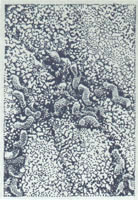Pleomorphism (microbiology) on:
[Wikipedia]
[Google]
[Amazon]
In microbiology, pleomorphism (from
 Monomorphic theory, supported by
Monomorphic theory, supported by
Ancient Greek
Ancient Greek (, ; ) includes the forms of the Greek language used in ancient Greece and the classical antiquity, ancient world from around 1500 BC to 300 BC. It is often roughly divided into the following periods: Mycenaean Greek (), Greek ...
, ''pléō'', "more", and , ''morphḗ'', form), also pleiomorphism, is the ability of some microorganisms to alter their morphology, biological functions or reproductive modes in response to environmental conditions. Pleomorphism has been observed in some members of the Deinococcaceae family of bacteria. The modern definition of pleomorphism in the context of bacteriology is based on ''variation'' of morphology or functional methods of the individual cell, rather than a heritable ''change'' of these characters as previously believed.
Bacteria
In the first decades of the 20th century, the term "pleomorphism" was used to refer to the idea thatbacteria
Bacteria (; : bacterium) are ubiquitous, mostly free-living organisms often consisting of one Cell (biology), biological cell. They constitute a large domain (biology), domain of Prokaryote, prokaryotic microorganisms. Typically a few micr ...
change morphology, biological systems, or reproductive methods dramatically according to environmental cues. This claim was controversial among microbiologist
A microbiologist (from Greek ) is a scientist who studies microscopic life forms and processes. This includes study of the growth, interactions and characteristics of microscopic organisms such as bacteria, algae, fungi, and some types of par ...
s of the time, and split them into two schools: the monomorphists, who opposed the claim, and the pleomorphists such as Antoine Béchamp, Ernst Almquist, Günther Enderlein
Günther Enderlein (7 July 1872 – 11 August 1968) was a German zoologist, entomologist, microbiologist, researcher, physician for 60 years, and later a manufacturer of pharmaceutical products. Enderlein received international renown for his ...
, Albert Calmette, Gastons Naessens, Royal Raymond Rife, and Lida Mattman, who supported the posit. According to a 1997 journal article by Milton Wainwright, a British microbiologist, pleomorphism of bacteria lacked wide acceptance among modern microbiologists of the time.
 Monomorphic theory, supported by
Monomorphic theory, supported by Louis Pasteur
Louis Pasteur (, ; 27 December 1822 – 28 September 1895) was a French chemist, pharmacist, and microbiologist renowned for his discoveries of the principles of vaccination, Fermentation, microbial fermentation, and pasteurization, the la ...
, Rudolf Virchow, Ferdinand Cohn
Ferdinand Julius Cohn (24 January 1828 – 25 June 1898) was a German biologist. He is one of the founders of modern bacteriology and microbiology.
Biography
Ferdinand Julius Cohn was born in the Jewish quarter of Breslau in the Prussian Pro ...
, and Robert Koch, emerged to become the dominant paradigm
In science and philosophy, a paradigm ( ) is a distinct set of concepts or thought patterns, including theories, research methods, postulates, and standards for what constitute legitimate contributions to a field. The word ''paradigm'' is Ancient ...
in modern medical science: it is now almost universally accepted that each bacterial cell is derived from a previously existing cell of practically the same size and shape.
Sergei Winogradsky
Sergei Nikolaevich Winogradsky (; ; , Kyiv – 24 February 1953, Brie-Comte-Robert), also published under the name Sergius Winogradsky, was a Ukrainian and Russian microbiologist, ecologist and soil science, soil scientist who pioneered the Biog ...
took a middle-ground stance in the pleomorphism controversy. He agreed with the monomorphic school of thought, but disagreed with some of the foundational microbiological beliefs that the prominent monomorphists Cohn and Koch held. Winogradsky published a literature review titled "The Doctrine of Pleomorphism in Bacteriology" in which he attempted to explicate the pleomorphic debate, identifying the fundamental errors within each side's argument. Winogradsky posited that pleomorphists Naegli and Zopf were unable to perceive the existence of bacterial morphological classes, and that Cohn and Koch, within their own suppositions, ignore species of morphologically variant bacteria that are unable to grow within axenic cultures. Winogradsky explained the perception of pleomorphic bacteria as bacteria progressing through different stages within a developmental cycle, thereby providing the fundamental structure for a theory of morphology based upon the concept of dynamic deviation from a morphological type, or biotype
{{Short pages monitor